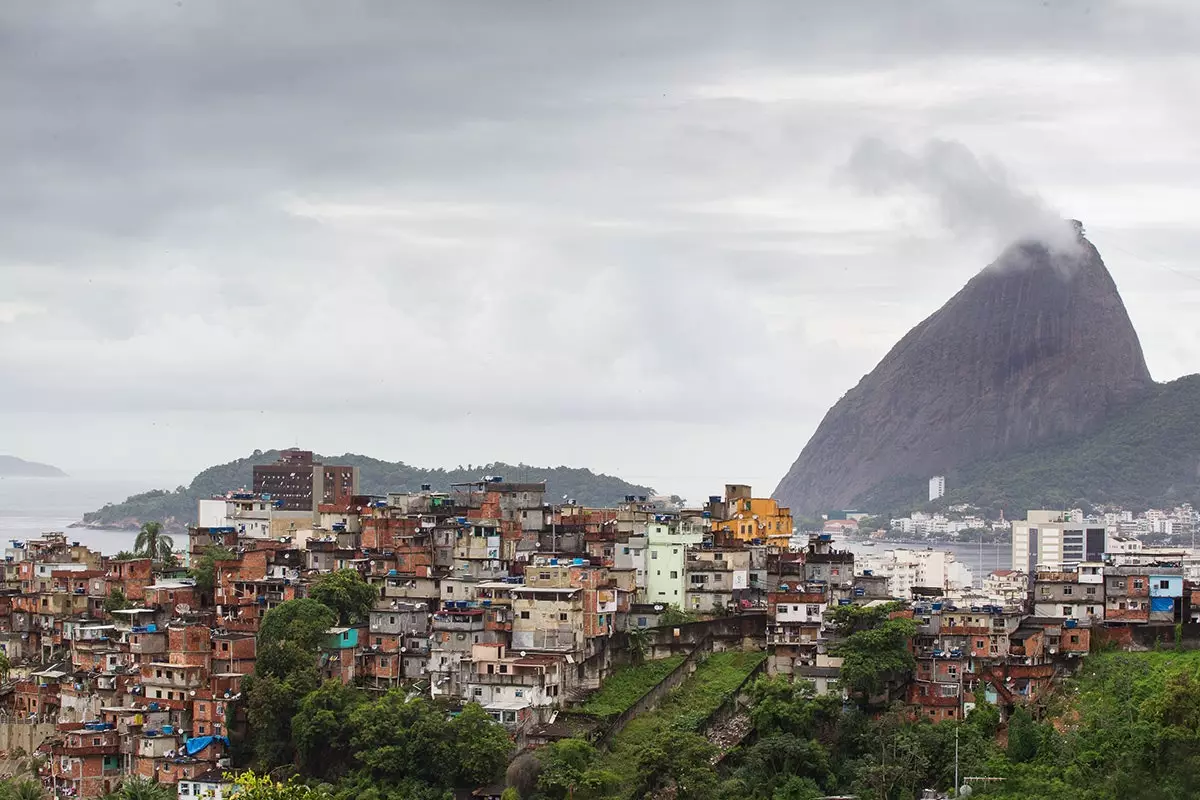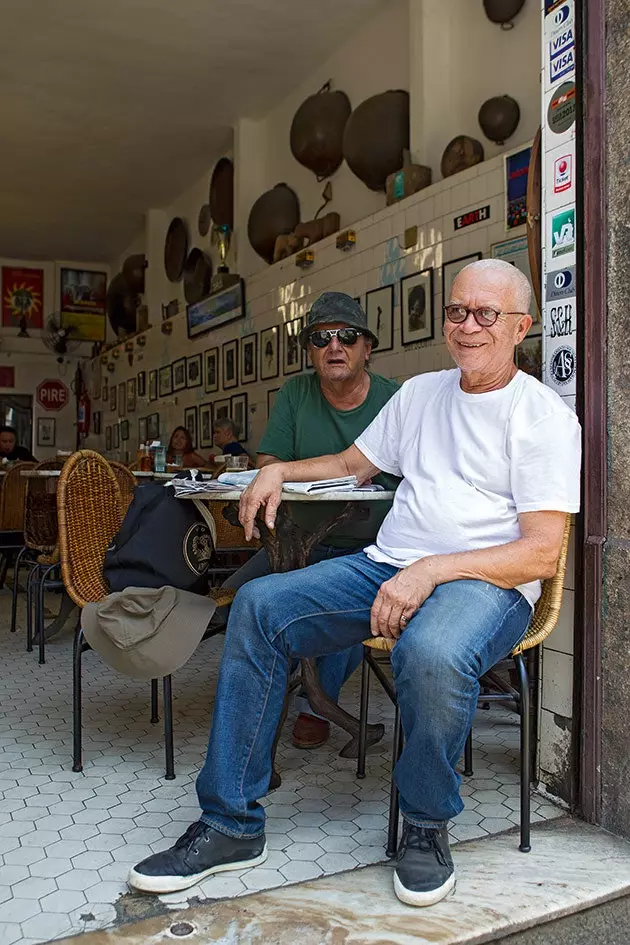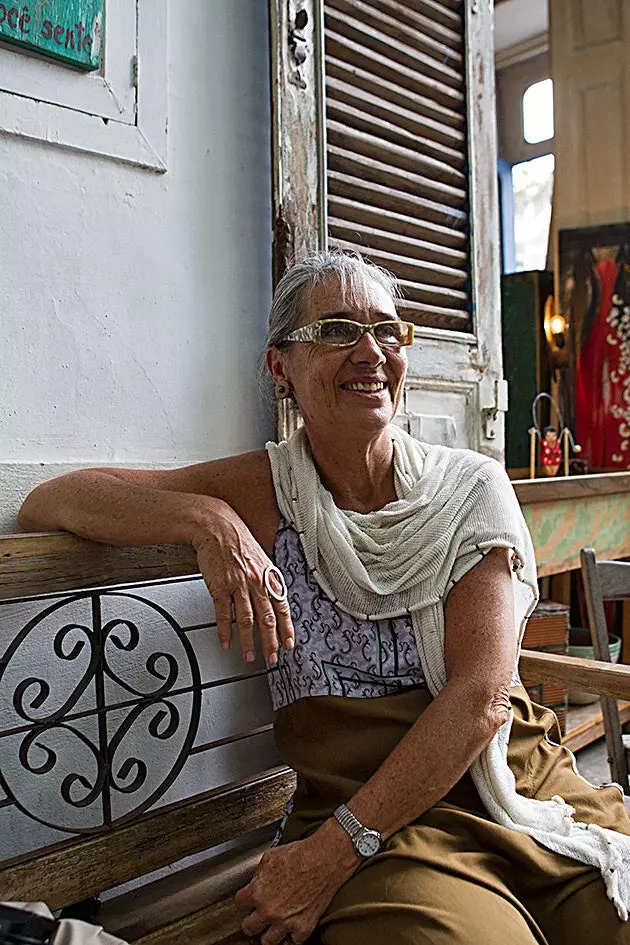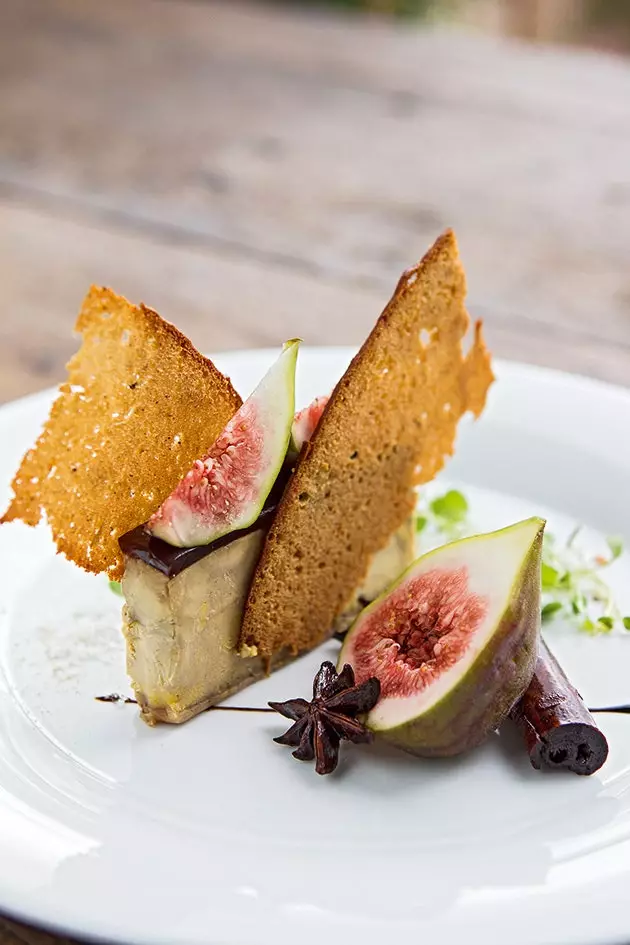
The neighborhood of Santa Teresa occupies a projecting hill with views of the famous Sugar Loaf
This is my third visit to Santa Teresa. The first time was in 1986 , when tourists still did not dare to visit this old aristocratic neighborhood that, at that time, was nothing more than a decadent artist ghetto . On the other hand, in 2007 the occasional foreigner was already swarming through its streets, no matter how hard the cariocas insisted on defining it as a dangerous neighborhood – which not even they would go to. Today, 27 years later and under heavy rain, although apparently not many changes are perceived, I can assure you that there are.
The corner food store, in Largo de Guimarães , has become a cultural bar, there are more travelers, the streets are very clean, there are more places to stay and good restaurants, but perhaps the most obvious change is the absence of the bondinho. Among the usual street art, you will come across posters and murals who demand the return of what was the last tram in operation in Brazil (until a tragic accident in 2011 made it withdraw from the streets along with its charm). His loud and colorful presence is missed . The cobblestone streets look desolate without him and the buses that supplant his route seem oblivious to their surroundings. We were told that it might be up and running again in mid-2014.

River seen from Santa Teresa
Overcome several decades of abandonment, this neighborhood of old mansions and narrow streets still resists, and is determined to flourish while avoiding being razed to the ground for that misnamed consumerism . Bars, restaurants, hotels and some souvenir and art shops are the only businesses that coexist with its leisurely life. This resistance has allowed him to maintain her romantic look.
You have to walk through its streets, explore and discover every corner, integrate and meet its particular characters, all related in some way to the arts in any of its expressions.
Every day, except Monday because it is closed, you can stop at the Bar do Mineiro to talk with its owner, Diogenes Paixao . From Carangola (Minas Gerais), he moved to Rio many years ago, where he has spent most of his life alternating stays in New York Y Paris . He has practically toured the main cities of the world just to visit his art galleries and museums.

Diogenes Paixão in his Bar do Mineiro
An art collector, he owns the most works by the Italian-Brazilian modernist artist Alfredo Volpi. In his collection there are also works by other artists such as Raymundo Colares Y Rubem Valentine . "I can't live without Art", he tells us after leading us in a lively talk through the different pieces hanging in the place, which opened in 1992. Ideal for drinking beers or eating the delicious feijoada, cod bolinhas and other delicacies, on Fridays and on Saturday nights it is the meeting point for artists, bohemians and art lovers from the neighborhood and from Rio. It was here that we met – and anyone can meet – the philosopher, poet, composer and theater director Jorge Solomon . An authentic, fun and spontaneous Bahian.
He tells us that he has written several books. “You're very pretty, and you look a lot like van Gogh...”, he told Daniel, the photographer, who from then on he would call Van Gogh. He gives us a few hours of conversation, stories and anecdotes, and invites us to a theater festival in the Armazém Cultural São Joaquim , in front of the Santa Teresa Cinema. Another of the bars in the neighborhood —and a hive of culture—, its owner, the Bahian actor Zéu Britto, organizes art days, exhibitions, poetry and concerts.

Marivi, owner of La Vereda
We took advantage of the rainy afternoon to enjoy the first day of the three-day theater contest, Eleven Sketches , some of a high level of interpretation. Across the street, the Cine Santa, which opened its doors ten years ago, is the only neighborhood theater that, with only 55 seats, has won five consecutive years the award for the largest cinema exhibitor Brazilian of the country, awarded by the Ancine (Agência Nacional do Cinema) . We still have rainy days, and although the cobbled ground is a bit slippery, we still go out for a walk. On the walls, graffiti, murals and many posters.
“More love please” and “Gentileza o carinho, e o respect more natureza” are the posters of the talented artist Ygor Marotta, who mixes street art and propaganda, in a kind of successful social movement in Brazil and Latin America whose intention is wake up society. “Eu I love you”, prays another. Messages not only of romantic love, but in an idealized sense: of responsibility, respect, education, compassion and kindness. On the corner of Rua Almirante Alexandrino and Largo do Guimarães, under a huge tree, you can find bonzoland , the endearing atelier Getulio Damado . He has lived in Santa Teresa since 1985 and his workshop is a bondinho built by himself.
Natural artist, miner of origin , creates his works from recycled materials: dolls and puppets with their own names and 'personalities' and small everyday objects and scenes inspired by memories of the past and by the people who pass in front of him. He also shapes thoughts and advice for the soul in signs he paints on wood, old mirrors or some other material that he finds around. It is impossible for him to leave without acquiring some of his genius. Another atelier from which we always leave with some piece, even if it is small, is that of Zemog and his wife, Rita. Rita is very serene. Zemog is extremely shy, even a little suspicious at first, but when you connect with him, his eyes become cheerful and he talks freely.
Scattered around his new workshop—bright, spacious, and with stunning views of Rio—are bags of color-coded bottle caps that they buy from favela kids. And it is that this couple of mining plastic artists use waste materials to devise fun and unusual pieces and installations, works represented by the art gallery Marcia Barrozo de Amaral , in Copacabana. Some of the works of the many artists of the neighborhood can be seen, along with other objects, organic coffee and chocolate, in the store The sidewalk , by Maria Victoria Matute.

Dolls in the atelier of the endearing Getúlio Damado
Mavi, as everyone knows them , she is Argentine and carefully selects what she sells in her store. She has been able to transform a dilapidated building into an eclectic space that she shares with the Rústico restaurant, owned by her son. Mavi has been a guardian of the essence of Santa Teresa for 25 years. The new residents of the neighborhood have also managed to capture the soul of it and keep it jealously. Jean Michel Ruis is French, elegant and sophisticated, and his two hotels reflect this. This is the second time we have stayed at Mama Ruisa , which was the first boutique hotel in Santa Teresa, and it is always a pleasure to enjoy its atmosphere and personalized attention.
It occupies a 19th-century mansion with high ceilings, seven rooms and halls exquisitely decorated with modernist furniture, pieces by local avant-garde artists, and Brazilian religious sculptures. On its walls they share the presence of photos of Josephine Baker, Colette and Maria Callas with drawings by Jean Cocteau and modern photographs. Jean Michel takes us to meet his new daughter, Doña Ruisa, a very bright house, meticulously decorated only with art deco pieces and with an incredible view of Guanabara Bay, the Bread of sugar and the neighboring favelas of the neighborhood.
Having breakfast on the balcony of any of its two accommodations transports you to the beginning of the 20th century, when the neighborhood was the place chosen by the carioca elite. We met François Delort, also French, in 2007, when he had just acquired a strategically located property: with good views and a colonial mansion of an old coffee plantation . At some point it had also been the hotel dos Descasados, because the recently separated men took refuge in it, but François restored the house and gardens and transformed it into the current one. Hotel Santa Teresa de Relais & Châteaux .
A paradise with wooden interiors and pieces of art from different parts of Brazil. He created an environment of tropical, ethnic and chic design. Within the walls of the property, whose exterior maintains a somewhat dilapidated appearance, is the excellent Tereze restaurant , led by the French chef Philippe Moulin, who has worked in The Palme d'Or , of Cannes, and in Les Crayères , in Reims, with two and three Michelin stars respectively. Térèze, in addition to an excellent menu, has magnificent views of Santa Teresa. Nearby, in a small 19th century building, the charming Natacha Fink opened the Espírito Santa restaurant in 2005. Small and sweet-spoken, this journalist from Manaus of Bolivian and Jewish-Dutch ancestry creates contemporary cuisine from the Amazon . Exotic dishes and products for both foreigners and Brazilians.

From the Térèze restaurant you can admire the Guanabara Bay
The New York Times mentions it as an essential gastronomic event for those who visit the city of Rio de Janeiro. One of the oldest and most classic restaurants in Santa Teresa is Aprazível , with spectacular views of Rio and run by the friendly brothers João and Pedro in a hidden house with a beautiful garden that smells like the jungle. His typically Brazilian cuisine could not be more homemade: the chef is his mother, Ana Castillo.
Climbing through the magnificent and exuberant gardens of Chácara do Céu , with 360o views over the city and Guanabara Bay, is the Castro Maya Museum. A modernist building designed by the architect Wladimir Alves de Souza in 1954 that houses the private art collection of Raymundo Ottoni de Castro Maya, with prints and drawings by artists such as Matisse, Modigliani, Miro , and with Brazilian art represented by modern artists such as Guignard and Antonio Bandeira and with an important group of works by Portinari.
Also surrounded by gardens, by appointment you can visit the atelier of the late designer Ricardo Fasanello , creator of iconic pieces and beautiful and functional objects such as the Esfera armchair or the Gaviota Bales armchair. Wearing resin, fiberglass, leather, steel and wood , Olivia, his widow, and a group of artisans continue with the handmade production of pieces such as the Anel armchair, just as Fasanello would have done. After this journey, I must confess that we did not mind the intense rain these days , since in reality we did not come to look for sun or beach. Santa Teresa beats art, culture, it is slow, silent, and a stronghold of good gastronomy, peace and culture just above the bustling River.
* This article is published in the May 74 Condé Nast Traveler magazine. This issue is available in its digital version for iPad in the iTunes AppStore, and in the digital version for PC, Mac, Smartphone and iPad in the virtual newsstand by Zinio (on Smartphone devices: Android, PC/Mac, Win8, WebOS, Rim, iPad) .
*** You may also be interested in...**
- Guide to Rio de Janeiro
- Charming favelas in Rio de Janeiro - Eleven ways to get to know Rio de Janeiro during the World Cup - The best restaurants in Rio de Janeiro
- The ABC of Rio de Janeiro

The views of Santa Teresa
